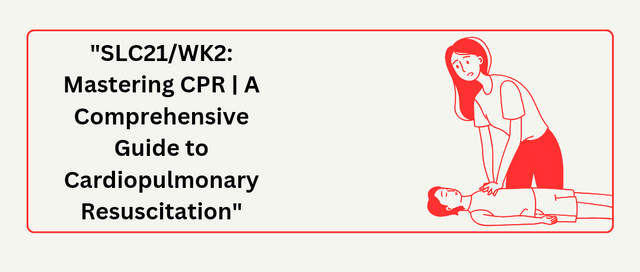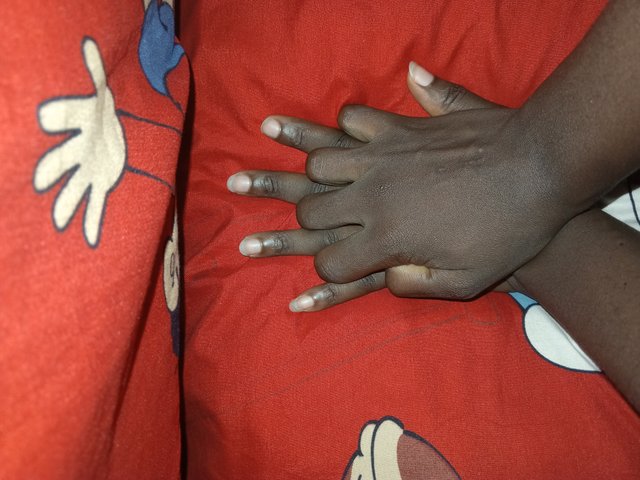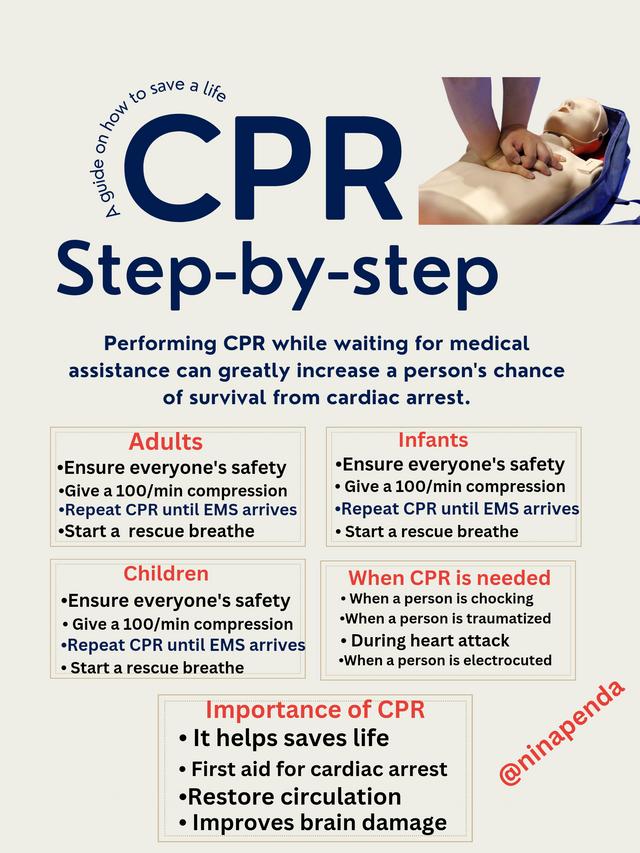
Perform all steps of cpr on a mannequin (your productivity) and explain each and every step in detail. Teach CPR to only 3 people (may it be your family, friends, relatives, or fellow mates and attach pictures of you teaching them)(Edited- if you don’t have a mannequin, use a firm pillow or stack of towels) |
|---|
My safety and the mannequin's safety are assured, and the mannequin won't respond if breathing isn't confirmed. This means I should ask someone in the crowd to call for help. Then, I can quickly start CPR on the victim.
When performing CPR, I must remember the DRABC steps. I need to check the airways to make sure they are clear.
I will start with adult CPR if my mannequin is an adult. I will kneel beside the mannequin and place my right hand on its chest, with the heel of my hand positioned halfway down the breastbone. My left hand will go on top of my right hand, with fingers interlocked. This method helps prevent fatigue during chest compressions. It's helpful to count the compressions out loud to keep focused.

Rescue breaths are done only when necessary. Many people hesitate to give them if the victim is not a relation. This concern may come from hygiene or the victim's condition, like bleeding or drooling. If I do give rescue breaths, I need to keep the victim's mouth closed and breathe into their mouth to prevent loss of air. No AED since I am alone, I need to focus on performing CPR by myself.
I stay alone, so I couldn't teach CPR to people physically. I was able to enlighten my neighbor but she wouldn't take a picture.
How to perform CPR on pregnant lady, obese people and weak elder people, write modifiable procedures for each in detail. |
|---|
CPR on a pregnant Lady
Chest compressions
Lay the person on their back on a solid surface. If you can, put something soft like a cushion or towel under their right hip to raise it slightly, keeping their shoulders flat. Kneel next to them.
Let the heel of one hand be placed on the lower part of the chest bone. Then the other hand should be placed on top of it.
Extend your arms and lean over the person's chest.
Use your body weight to push straight down on their chest by about one-third of its depth, which is usually over 5 cm.
Let go of the pressure. Lift your hands a bit off the chest after each compression to let the chest fully rise. Each compression includes pressing down and then releasing. The time for compressions and releases should be the same.
Do 30 chest compressions quickly and firmly, aiming for about 2 compressions every second or 100-120 per minute. Counting out loud can be useful.
Rescue Breaths (mouth-to-mouth)
After 30 chest compressions, provide 2 rescue breaths. First, open the person's airway. Tilt their head back and lift the chin by placing one hand on their forehead and the other under their chin.
Open their mouth with one hand and exhale steadily for about 1 second and watch for the chest to rise. Then, observe for the chest to fall. Do this again and provide a second rescue breath.
CPR on obese people
Chest compression
When giving CPR to an obese person, make sure the compressions are at least 2 inches deep and done at a speed of 100-120 compressions per minute. Because of the extra body weight, rescuers might need to use more strength to reach the right depth. Training with CPR manikins that mimic obese patients can help rescuers improve their skills.
Determine strength
In cases where there are many bystanders, it can be helpful for the biggest and strongest person to do chest compressions. This ensures the compressions are deep enough to keep someone alive until help arrives. Having strength and stamina is important to make sure the compressions are both deep and steady.
Continuous compressions
If giving rescue breaths is not safe or possible because of the patient's size or other reasons, you should do continuous chest compressions (hands-only CPR). Continuous compressions work better than trying to give rescue breaths that may not be effective and help keep blood flowing.
CPR on weak elder people
Check responsiveness: Calmly walk up to the person so you don't scare them. Lightly tap their shoulder and speak loudly to see if they respond.
Call for help: If the person doesn't reply, call emergency medical services (EMS) right away. Use a mobile phone on speaker mode if you can, so you can begin CPR while speaking to the dispatcher.
Breathing: Watch their chest movement by putting your ear close to their mouth and nose. Remember that older adults might breathe more slowly, less deeply, or irregularly because of age or health issues. If you are uncertain, it's better to be safe and start CPR.
Carry out chest compression: Let the heel of one hand be placed in the middle of their chest and let the other hand rest on top, then lock the fingers together. Make sure your elbows are straight and your shoulders are right above your hands to use your body weight for compressions.
Mouth-to-mouth ventilation: Give 2 breaths after every 30 chest compression. Be aware of possible issues like dentures that might need to be taken out to keep the airway clear. Look for anything blocking the mouth before providing breaths.
Cardiac arrest (AED): Automated external defibrillators (AEDs) are essential tools during cardiac arrest emergencies. If you find an AED, grab it quickly and listen to the voice instructions. When using an AED on an older adult, it's important to think about possible challenges and advantages, such as their current health issues and preferences for end-of-life care.
Continuous CPR: Keep doing CPR by switching between chest compressions and breaths (if you are giving breaths) until help arrives or the person starts to show signs of life like moving, coughing, or breathing. It's very important to keep going with CPR until the person can be taken to the hospital to increase their chances of survival.
Support emotionally: Provide comfort and emotional help to family members or caregivers who are there. Describe your actions and reasons to reduce their worries.
Write an explanation for all the mistakes people make during CPR, as we highlighted in the class topic |
|---|
• Incorrect hand placement during CPR can happen. We might put our hands on the chest in the wrong spot, not below the breastbone. We could also have our arms too long or too short.
• Chest compression pressure is not enough. We might not be meeting the recommended pressure levels and not observing proper recoil. When we push on the chest, we sometimes forget to let it come back up.
• Continuing CPR even when tired can lead to weak chest compressions, which are not effective.
• Stopping CPR at the first sign of body movement often undoes the progress that has been made.
• The Rescuer might apply heat compression too quickly or too slowly, in addition to the pressure mentioned earlier.
• Performing CPR on a soft or bouncy area is not effective. It goes against the purpose of proper chest compressions.
Plan a simple campaign to raise awareness about CPR in your community. Write down the main goal of your campaign, who you want to reach (your target audience), and key messages you want to share. Think about how you can spread the word (like using social media or holding a community event). Your plan should be clear and include a basic timeline showing when you will do each part of the campaign. (You only have to devise a working plan and not practically implement it.) |
|---|
My main goal for this campaign is to great awareness on CPR and it's importance and how it could aid to save lives.
My target audience would be people from 18+. People with prior health experience, and those in social care settings, along with business and community groups.
Key point to share,
• Learning CPR is simple.
• CPR works well.
• People of all ages can perform CPR.
• CPR can help save lives that seem lost.
• CPR is the initial response for heart emergencies.
&
Campaign Report
| Campaign Name | Community CPR and awareness |
|---|---|
| Hosting campaign | "Ninapenda's Cardio CPR Community Awareness" |
| Campaign duration | 12 weeks |
| Medium of awareness | Door to door, social media platforms, Hands on training event |
| Week 1&2 | social media reach outs and teachings |
| Week 3-6 | Collaboration with other health institutes through some information materials |
| Week 7&8 | Media promotions |
| Week 9-12 | Physical Training |
Design a simple infographic (Illustration) that summarizing the basic steps of CPR for adults, children, and infants, including why CPR is important and list situations when CPR might be needed (like drowning or heart attacks) |
|---|

Student Name: @ninapenda
Overall Grade: 7.1/10
Plagiarism Check: Pass
AI Use: No
General Feedback:
The student demonstrated strong foundational knowledge in CPR techniques and campaign planning, effectively addressing each question with detailed responses. However, expanding on practical applications and addressing design and planning specifics would make the responses more comprehensive and accurate.
Regards,
@abdu.navi03
Downvoting a post can decrease pending rewards and make it less visible. Common reasons:
Submit
Oh this is great of you, I can see from your post your understanding of CPR and with this explanation, you can safe life.
Your plan on CPR is awesome, 12 weeks is enough time to learn.
Wishing you success 👍
Downvoting a post can decrease pending rewards and make it less visible. Common reasons:
Submit
Thank you ma'am
Downvoting a post can decrease pending rewards and make it less visible. Common reasons:
Submit